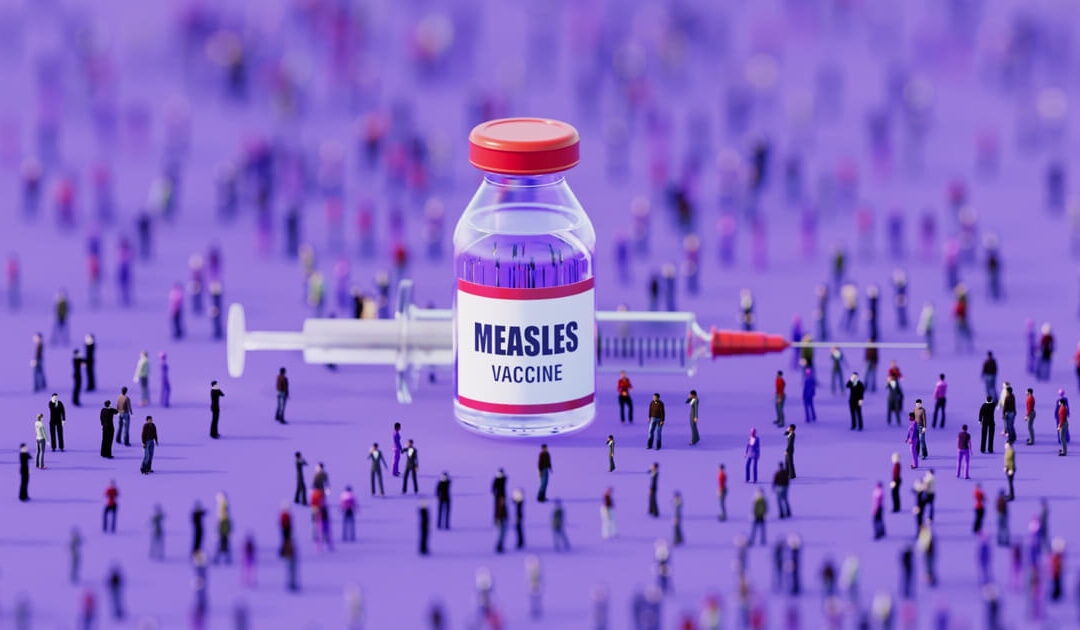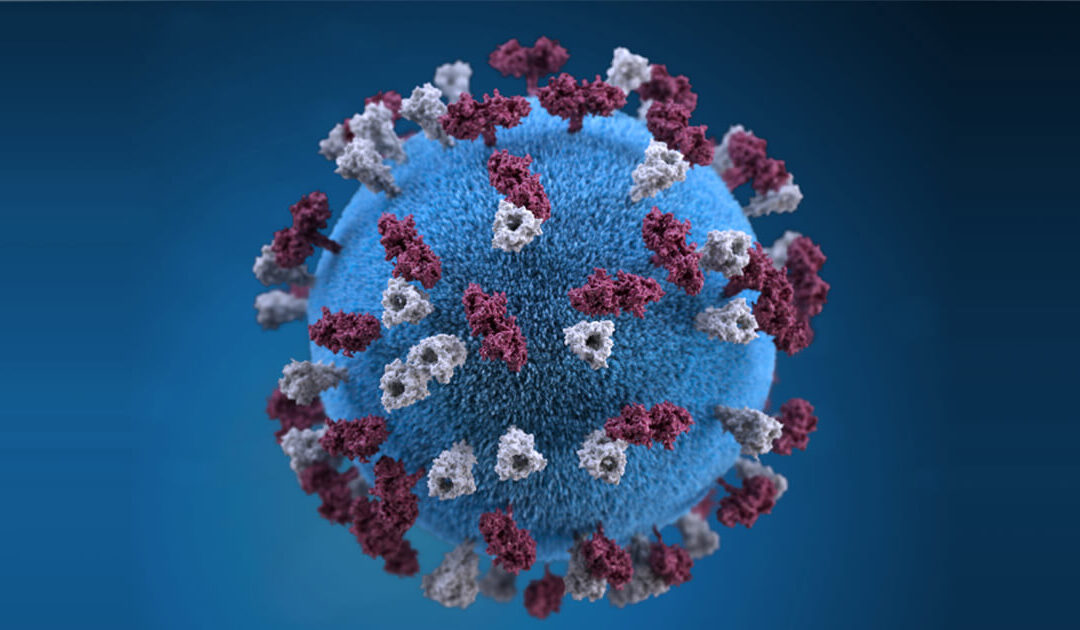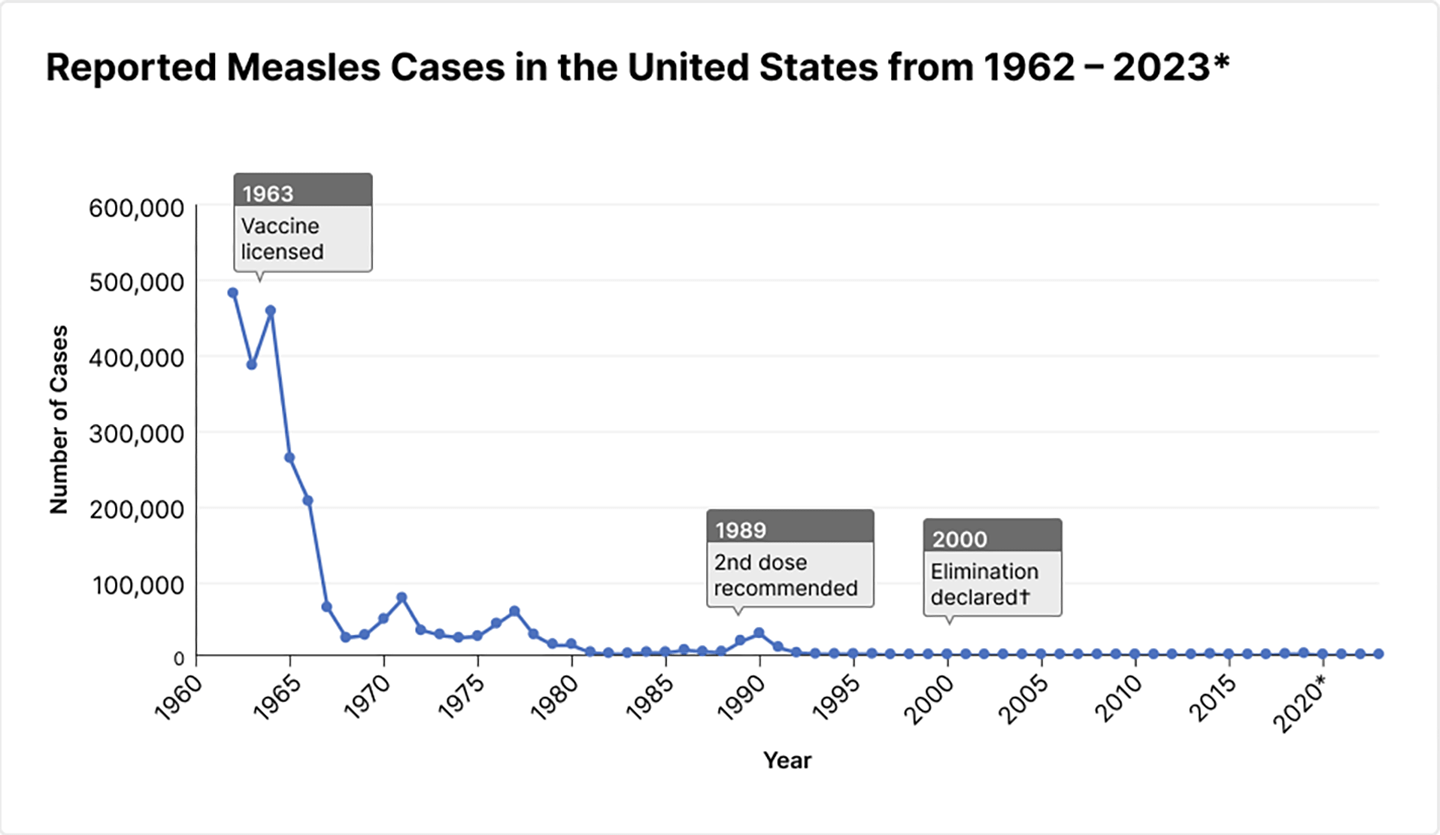What you need to know about the latest outbreak in the United States.


Who Gets Measles and Why Is it Back?
March 11, 2025
What You Need to Know About the Latest Outbreak in the United States
For over two decades, measles was a long-forgotten disease in the United States thanks to widespread vaccination and elimination of the virus from circulation. However, as cases rise once again and at least one child has died, it’s a reminder of how dangerous the virus is and how quickly it can return when vaccination rates decline.
Before the introduction of the measles, mumps, and rubella (MMR) vaccine in 1963, the United States saw an average of 3-4 million people infected with the virus, resulting in an average of 400-500 deaths, 48,000 hospitalizations, and 1,000 instances of permanent disability each year ![]() . In the 1950s, it was estimated that over 90% of the population
. In the 1950s, it was estimated that over 90% of the population ![]() had been sick with measles by the age of 15.
had been sick with measles by the age of 15.
With the licensing of the vaccine in 1963, the United States experienced a significant drop in measles cases to the point the virus was no longer spreading continuously in the population.
However, the virus can still be imported from regions of the world where it has not been eliminated leading to localized outbreaks. An ongoing outbreak ![]() in Texas has led to the country’s first measles-related death in nearly a decade
in Texas has led to the country’s first measles-related death in nearly a decade ![]() .
.
So What are Measles and Why is the Virus So Harmful?
Measles virus is the most contagious human virus on Earth and poses a far greater threat than the common cold.
Due to its interaction with vital systems in the body, measles can lead to long-term disabilities including blindness and inflammation of the brain ![]() (encephalitis) which may result in permanent brain damage. The measles virus can also weaken the immune system
(encephalitis) which may result in permanent brain damage. The measles virus can also weaken the immune system ![]() for long stretches of time after the initial symptoms dissipate. This allows other pathogens to infect the person more easily and these can lead to serious outcomes such as pneumonia.
for long stretches of time after the initial symptoms dissipate. This allows other pathogens to infect the person more easily and these can lead to serious outcomes such as pneumonia.
Measles virus spreads through respiratory droplets, meaning that breathing the same air as an infected person or touching a contaminated surface can lead to infection. In fact, the measles virus is so contagious that 9 out of 10 people ![]() who lack immunity will contract the infection after contact with an infected individual. The virus remains contagious in the air and on surfaces for up to two hours.
who lack immunity will contract the infection after contact with an infected individual. The virus remains contagious in the air and on surfaces for up to two hours.
After the virus sets up an infection it spreads rapidly in the body hijacking the cell’s machinery to reproduce. Infected cells in the blood carry the virus to the lungs, other organs, and even the brain.
Contracting measles is very serious. In fact, 1 in 5 infected people without prior vaccination will require hospitalization ![]() .
.
What Are the Symptoms?
Measles virus is characterized ![]() by a high fever (potentially as high as 105℉), and what clinicians refer to as the three “Cs”: cough, coryza (runny nose), and conjunctivitis (red, watery eyes). These first symptoms typically emerge one to two weeks after exposure to the virus.
by a high fever (potentially as high as 105℉), and what clinicians refer to as the three “Cs”: cough, coryza (runny nose), and conjunctivitis (red, watery eyes). These first symptoms typically emerge one to two weeks after exposure to the virus.
Once these symptoms begin, typically within two to three days, Kolpik spots ![]() (white dots with reddish background) can be seen lining the mouth. Within three to five days of the onset of the first symptoms, the characteristic measles rash appears with red dots that begin near the hairline and trunk and spreading to the extremities (or hands and feet). An infected person is typically contagious four days before and four days after the onset of the rash.
(white dots with reddish background) can be seen lining the mouth. Within three to five days of the onset of the first symptoms, the characteristic measles rash appears with red dots that begin near the hairline and trunk and spreading to the extremities (or hands and feet). An infected person is typically contagious four days before and four days after the onset of the rash.
The Power of Vaccination
The measles vaccine, currently administered in the MMR, is the only effective prevention against measles and is 97% successful ![]() . The first dose of the MMR vaccine
. The first dose of the MMR vaccine ![]() is typically given between 12-15 months old, with the second dose administered between the ages of 4–6 years.
is typically given between 12-15 months old, with the second dose administered between the ages of 4–6 years.
While the vaccine has proven to be highly effective, some individuals who were vaccinated prior to 1968 may have received a weaker version of the vaccine ![]() . Additionally, the recommendation of two doses of the MMR vaccine did not occur until 1989
. Additionally, the recommendation of two doses of the MMR vaccine did not occur until 1989 ![]() , so people born before then have likely received only one dose. Those individuals may want to discuss a booster shot with their physician.
, so people born before then have likely received only one dose. Those individuals may want to discuss a booster shot with their physician.
It is important to remember that being unvaccinated is not the only factor that puts individuals at risk. People who are immunocompromised, such as those receiving chemotherapy or who are pregnant, and those who cannot be vaccinated for medical reasons are also particularly at risk.
The outbreak in Texas earlier this year illustrates the importance of maintaining “herd immunity ![]() .” This occurs when a large portion of a population is immune to a disease through natural infection or vaccination. High levels of preexisting immunity make it very difficult for the virus to spread.
.” This occurs when a large portion of a population is immune to a disease through natural infection or vaccination. High levels of preexisting immunity make it very difficult for the virus to spread.
Herd immunity protects those who cannot receive the vaccine due to medical conditions by completely restricting or greatly lowering virus spread. In the absence of natural transmission due to elimination of the virus, vaccination is essential to provide herd immunity. It reduces the risk of infection for everyone, even those who are unvaccinated. We’ll explore the power of herd immunity in a future blog post.
The Texas Outbreak: A Case Study in Low Vaccination Rates
The first cases reported in Gaines, TX, ![]() earlier this year were in two unvaccinated adults who had recently traveled internationally. In the first month since these cases were brought to the public’s attention by the Texas Department of Health on Jan. 23, that number rose to nearly 200 cases
earlier this year were in two unvaccinated adults who had recently traveled internationally. In the first month since these cases were brought to the public’s attention by the Texas Department of Health on Jan. 23, that number rose to nearly 200 cases ![]() .
.
The area of Gaines, TX, has one of the highest vaccine exemption rates in the U.S. at 18% ![]() . In comparison, the exemption rate in Allegheny County in 2023-2024
. In comparison, the exemption rate in Allegheny County in 2023-2024 ![]() was reported as 3.2%.
was reported as 3.2%.
The measles vaccine is an example of how medical advancements have drastically reduced disease and saved lives. As case numbers continue to increase and other outbreaks occur in 2025, the death of a child in Texas is a tragic reminder of the vital role science plays in public health.
Understanding the data, recognizing how diseases spread, and staying informed about prevention strategies help us all contribute to healthier communities.
To learn more about how to protect your health and the health of your community, talk to your physician or contact the Allegheny County Health Department ![]() .
.

Myths and Misconceptions: Is Vitamin A a Cure-All for Measles?
With measles cases on the rise in the United States, some people are looking for alternatives to vaccination – such as vitamin A. Home > Blog April 7, 2025 by Robin Oliverio, Ph.D. With measles cases on the rise in the United States, some...

Measles and Herd Immunity: What It Is and How It Protects Our Community
The recent measles outbreaks in the United States serve as an important reminder of the power of vaccinations and the role of community protection in the fight against infectious diseases. Home > Blog March 25, 2025 by Robin Oliverio, Ph.D....

How Unique is the Recent Measles Outbreak?
A Look at Measles Trends Nationwide and How Allegheny County Compares. Home > Blog March 18, 2025 by Robin Oliverio, Ph.D. A Look at Measles Trends Nationwide and How Allegheny County Compares This is the second story in a...



